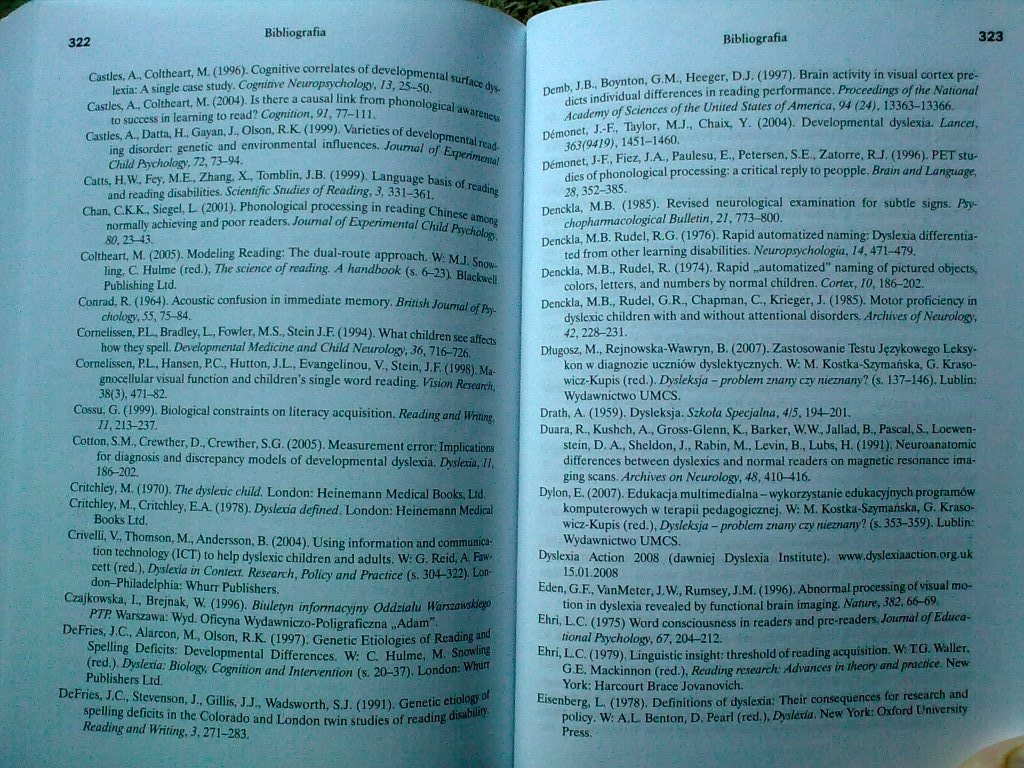Zdjęcie4033

322 Bibliografia
CostJes. Am Colthcart, M. (1996). Cognitive corrclalcs of dcvclopmcnul turlać? d)v luia: A single case Siudy. Cognirire Neuropsychotogy, 13, 25-50.
Castlcs, A.. Collhcart, M. (2004). ls Ihcre a causal link from phonologicii dwareon to succcss in leaming lo rcad? Cognition, 91, 77—1II.
CastJes. A., Dalia. Hm Gayan. J-, Olson. R.K. (1999). V4irieties of dcvełopmcnUil rcad ing disorder: genelic and environmental influonces. Journal uf Ejcperimoua! Child A>rhology. 72, 75-94.
Gal(5. H.W. Fey. M.E.. Zhang, X.. IbmbJin. J.B. (1999). Language hasis of reading and reading disabilitic*. Scientific Srudies of Reading, 3, 531-36L ■
Chan. C.KJC. Sicgei. L (2001). Pbonological Processing in reading Chincse among normally achieying and poor readers. Journal of Experimenial Child AycAdon 80.23-43.
Collhcart. M. (2005). Modcling Reading: The dual-roulc approach. W: MJ. Sno* ling. C. Halnie (red.), The science of reading. A handbook (s. 6-23) Black* ci Publishiog Lid.
Conrad. R. (1964). Acoustic confusion in immediatc mcmory. Bńtish Journal of Pt) choiogy. 55, 75-84.
Comelissen, RL, Bradley, L_, Fowler, M.S., Stein J.F (1994). What chiłdren sec afiecb how they spell. Deselopmenial Medicine and Child Neurology, 36, 716-726. Comelissen. P.L.. Hanscn, P.C, Hutton. J.L., Evangelinou. V., Stein. J.F. (1998). Ma gnocelłular visual fu net km and children*s single word reading. Kston Rntanh. 38(3), 471-82.
Cbssu. G. (1999). Biologtcal constraints on literacy acquisition. Reading and IHurn 11,2J3-237.
Cotton, S-M.. Crewthcr, D.. Crcwthcr. S.G. (2005). Measuremcnt error: Implkaiioai for diagnosis and discrcpancy modela of devclopmcnlal dysłeria. Dwteda.U, 186-202.
Crilchley, M. (1970). The dysJedc child. London: Hcinemano Mcdical Books. Ud
Critehlcy, M., Crilchley. E.A. (1978). Dyslaaa defined. London: Heinemann MedkaJ Books Lfd.
Crńrelli, V, Thomson. M., Andersson, B. (2004). Using Information and commuaic* bon iechnology (ICT) to help dyslcx»c chiłdren and adults. W: G. Re id, A h*-celt (red.). Dystoda m Contexr. Research, Policy and Practice (&. 304-322). Lon don-Philadclphia: Whurr Publishcrs.
Czajkowska. I.. Brejnak. W. (1996). Biuletyn informacyjny Oddziału Hanzawsticp' PTP. Warszawa: W^fd. Oficyna Wydawniczo-Poligraficzna ..Adam*.
DeFries, J.C, AJarcon, M.. Olson. RJC. (1997): Genelic Etiologiem of Reading ud Speiling Deflcits: Dcvelopmental Differences. W: C. Hulmo, M. Sno*lmg (red.). DysJeria: Bio/ogy, Cognition and Inlervenrion (s. 20-37). London: Whun Publishcrs Lid.
DeFries. J.C,, Sicvcnson, J., GUlis. JJ„ Wadsworth. SJ. (1991). Genelic ctiota0 | speiling deficits in the Colorado and London twin studies of reading dMttr Reading and Wtiting, 3,271—283.
Demb. XB„ Boynton, G.M.. Hcegcr, DJ. (1997). Brain acthnty in vi$ual eona pre-dicts individual diffcrenccs in reading performance. Proceedings of the National Academy of Sciences of the United States of America, 94 (24), 13363-13366.
Dćmonct, J.-F., Taylor, MJ., Chau, Y. (2004). DcvdopmenUl dys!exia. Lancet. 363(9419), 1451-1460.
Demonet, J*F., Fiez, J.A., Paulcsu, E., Pctersen, &B;:, Zatorre, RJ, (1996). PET stu-dies of phonological processing; a critical reply to peopple. Brain and Language, 28,352-385.
Denckla, M.B. (1985). Revised neurological examination for subtle signs. Psy-chopharmacological Bulletin, 21,773-800.
Denckla, M.B. Rudel, R.G. (1976). Rapid automatized naming: Dysleua differentia-led from other learning disabflitics. Ncuropsychologui, 14,471-479.
Denckla, M.B., Rudel, R. (1974). Rapid „automatized" naming of picturcd objeets, cokns, letters, and numbers by norraal chiłdren. Cortex, 10,186-202.
Denckla, M.B., Rudel, G.R„ Chapman, G, Krieger, J. (1985). Motor proBcicncy in dysleńc chiłdren with and without attemional disorders. Archncs ofNeuroh®, 42,228-231.
Długosz, M., Rejnowska-Wawryn, B. (2007). Zastosowanie Testu Językowego Leksykon w diagnozie uczniów dyslektycznych. W M. Kostka-Szymańska. G. Kraso-wicz-Kupis (red.). Dysleksja -problem many czy nieznany ? (i. 137-146). Lublin: Wydawnictwo UMCS.
Drath, A. (1959), Dysleksja. Szkoła Specjalna, 4/5,194-201.
Duara, R„ Kushch. A., Gross-Glenn, K., Barkcr, W. W, Jallad, B., Pascal, S., Locwen-stcin, D. A., Sheldon, J., Rabin, M. Levin, B . Lute, H. (19911 Neuroanatomie diffcrenccs bctwccn dyslcxics and norma! readers on raagnetie resonancc ima-ging seans. Arcłu\es on Neurology, 48,410-416.
Dylon, E (2007). Edukacja multimedialna-wykorzystanie edukacyjnych programów komputerowych w terapii pedagogicznej. W: M. Kostka-SzymańsJca, G. Kraso-wicz-Kupis (red.), Dysleksja - problem znany czy nieznany? (s.353-359). Lublin: Wydawnictwo UMCS.
I Dyslexia Action 2008 (dawniej Dyslcxia Institute). www.dyslexiaaction.org.uk 15.01.2008
Eden, G.F.. YanMeter, X W., Rumsey, XM. (1996). Abnonnal processing of Wsuai mo-tion in dyslexia revealed by functional brain imaging. Naturę, 382,66-69.
Eltri, LC. (1975) Word consciou&ness m readers and pre>readers. Journal of Educa-iional fSydioiogy, 67.204-212. '-'fr j
Ehri, L.C. (1979). Unguistic insight: threshold of reading acquiiitioo. W TO. Whlkr. G.E. Mackinnon (red.), Reading rcsearch; Advances in theory andpmcdce, New York: Hurcourt Bruce Jovanovich.
Eisenberg, L (1978). Definiiions of dyslena: Their consequenc*s for rcsearch and policy. W: A.L Benton. D. Pearl (red.), Dyslezia. New York: Oxford Uwren.ty Press.
L
Wyszukiwarka
Podobne podstrony:
Zdjęcie4036 328 Bibliografia Hart. R-. Kcm-all. R (2001). Impaircd Processing of rapid stimulus sei
Zdj?cie0951 —• siarczan arrizmzm^ Z) wódz am o sale~~z amonomrz u mocznik
AKADEMIA MORSKA SZCZECINBibliotekaIlliS Biblioteka Głowna AM zajmuje dwa piętrapynMai Wydziału
Z ŻYCIA SBP 295 Czasopisma Bibliotekarz i Poradnik Bibliotekarza ukazywały się w I. 1993-1996 regula
94 (4) Biblioteka Główna AM Gdynia
Zdjęcie0120 łf Jnjdłwin■■!■■
Zdjęcie0279 Wym<>u-*niftdoty< /»• » wyglcylii (Am* i>«*n> ^ 0U*jułrem**»U) wymagania
Zdjęcie4032 320 Bibliografia Bogdanowicz. M. Adryjanck. A (2004). Uczeń z dysleksją w okolę. Poradni
Zdjęcie4034 324 Bibliografia Ellis, N„ Largc, B. (1987). The devdopmcn( of reoding: As you scck so s
Zdjęcie4035 326 Bibliografia Gaywa. J- Soi Ib. S.D„ Cberny, S-S.. Cardon, L-R- Fułker, D.W.. Kjmbert
Zdjęcie4037 330 Bibliografia Knvali K.A., Forness, S.R. (2000). Whai dcfinitions of Icaming dHabilii
Zdjęcie4038 332 Bibliografia Lovcgrt>vc, WJ.. Bowling, A . Badcock, D. Blnckwood, M. (1980). Spc
Zdjęcie4039 934 Bibliografia Nation, K., Snowling, MJ. (1998). Individual diffcrences in contcrtual
Zdjęcie4040 336 Bibliografia Pietras, f. (2006). Dysortografia - problemy psychologiczne. Gdańsk: Wy
Zdjęcie4041 338 Bibliografia Sharc. DL <1995). Phoootogkml rccoding and aelf-ceaching: smr tjua n
Zdjęcie4042 340 Bibliografia Sprenger-CharoHo*. L, Cole, R, .Semiclaw, W. (2006). Reading acr/utslrt
więcej podobnych podstron